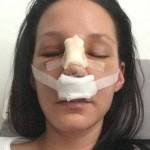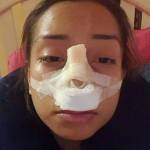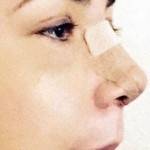Uneven swelling after rhinoplasty
Uneven swelling after rhinoplasty can be very significant and easily hide the eventual result.
Your appearance right after the splint was removed is more accurate than how it looks two weeks later.
As a general rule, you can not evaluate the results for 3-6 months and the final result is at one year.
Try to be patient and discuss your concerns with your surgeon. (Steven L. Ringler, MD, FACS, Grand Rapids Plastic Surgeon)
Swelling after Rhinoplasty: Waiting is the hardest part!
This is the toughest part of rhinoplasty – waiting patiently for the swelling to go down.
As others have mentioned, the soft plastic cast and tape which are placed after the surgery help to keep the swelling down and to get the soft tissues reattached to the underlying framework (bones and cartilage).
After these are removed, some swelling will accumulate in the nose. Depending on the amount of work that was done, the thickness of your skin, and other healing factors, this may take a few weeks to a few months to completely resolve.
In some cases, targeted injections of a steroid can help it along. Best of luck, and stay in touch with your surgeon. (Evan Ransom, MD, Bay Area Facial Plastic Surgeon)
When Did Swelling Go Down After Your Rhinoplasty Surgery
Usually the nose looks great when the initial splint and steristrips are removed then once the splint has been removed swelling begins and it is this next phase of swelling that can take so long to complete. Swelling can go on for weeks, months , and sometimes a year before it finally settles down. (Paul Vitenas, Jr., MD, Houston Plastic Surgeon)
- Uneven swelling after nose job
- Uneven swelling after rhinoplasty in black
- Uneven swelling after rhinoplasty images
- Uneven swelling after rhinoplasty operation
Tip swelling after rhinoplasty
4-5 months following open rhinoplasty, there is STILL enough tip swelling to obscure your final expected tip size and definition.
This swelling resolves, and the tip continues to shrink and heal for up to 18 months after your procedure, and perhaps even longer. (Steve Laverson, MD, San Diego Plastic Surgeon)
Tip swelling is the last to go away.
Small world; I trained there. Swelling of the tip is the last to go away. If nothing was done to the tip then it should regain its former appearance once all of the swelling has subsided.
The time for this to occur is different from one individual to another. At 4 months I would anticipate most of the swelling should have resolved. (Remus Repta, MD, Scottsdale Plastic Surgeon)
Tip swelling can last for up to a year. Occasionally, some careful injection of a cortisone preparation into the tip could help expedite the process.
Ask your doctor about cortisone injections. (Elliot M. Heller, MD, New York Facial Plastic Surgeon)
Swelling after Rhinoplasty
After reviewing your pictures it appears that you achieved a very natural and aesthetically pleasing result from your rhinoplasty.
I understand that you are concerned about prolonged swelling in the tip, but you need to realize that swelling after rhinoplasty surgery takes up to one year to fully resolve.
Over the course of the next 8 months you will continue to see the shape of your nose mature into its final conformation. In the meantime be patient, and follow up with your surgeon if you have any specific questions. (Anthony Corrado, DO, Philadelphia Facial Plastic Surgeon)
Tip hard 4 months after Open Rhinoplasty
Open Rhinoplasty causes more swelling in the tip than Closed Rhinoplasty and typically takes 6 months for the swelling to decrease. Wait a few more months and see what happens at that time. (Francis R. Palmer, III, MD, Beverly Hills Facial Plastic Surgeon)
Tip swelling after open rhinoplasty often takes six to twelve months following surgery to resolve. I would give your nose more time to heal. (Larry Fan, MD, San Francisco Plastic Surgeon)
Swelling In Tip, Last To See Resolution
It’s not unusual for patients to have prolonged swelling following rhinoplasty. This swelling can result in loss of definition of the nasal structure. It can also cause the nose to be stiff and firm. Several factors, including the use of open rhinoplasty, fracture of the nasal bones, thickness of the nasal skin and a previous rhinoplasty have been associated with prolonged swelling.
Most patients will note significant swelling for about 2 to 4 weeks following surgery.After two weeks most patients are comfortable resuming their normal lives and going out in public. Swelling will persist in most patients for at least one year following surgery, with the nasal tip being the last site to experience resolution.
In the immediate post-operative period, nasal splints elevation of the head, and ice can be used to minimize swelling. When this situation arises, it’s important to maintain good communication with your plastic surgeon. Swelling is a normal part of healing and it’s therefore important to be patient.With time it should resolve and the vast majority of patients are ultimately happy with their rhinoplasty. (Richard J. Bruneteau, MD, Omaha Plastic Surgeon)



